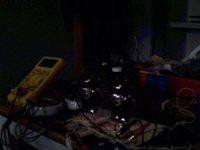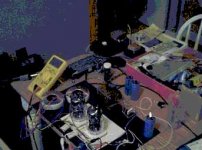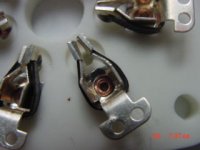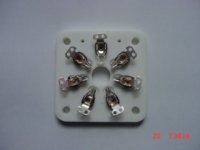Here is some good reading
http://otlamp.com/articles/6c33/dorsey/
and an interesting design
http://otlamp.com/articles/6c33/dorsey/amp.gif
http://otlamp.com/articles/6c33/dorsey/
and an interesting design
http://otlamp.com/articles/6c33/dorsey/amp.gif
6c33cb SE
I myself find this tube also for SE-Operation as long as you take care about a few things:
- the driver should be able to serve the input capacitance of the 6c33 - forget about a 6SN7 or equivalent. I am using a 6DN7 as a driver - heard also good things about C3M,
- 45W plate-dissipation should be the limit,
- drill holes in the chassis around the socket (heat IS a problem..)
This configuation plays perfect - I have around 13W output, great "easy" but yet powerful sound and I like it very much. This is the first SE I build after a couple of PP-configurations and it really was worth it.
Marcus
I myself find this tube also for SE-Operation as long as you take care about a few things:
- the driver should be able to serve the input capacitance of the 6c33 - forget about a 6SN7 or equivalent. I am using a 6DN7 as a driver - heard also good things about C3M,
- 45W plate-dissipation should be the limit,
- drill holes in the chassis around the socket (heat IS a problem..)
This configuation plays perfect - I have around 13W output, great "easy" but yet powerful sound and I like it very much. This is the first SE I build after a couple of PP-configurations and it really was worth it.
Marcus
Sockets
Hello ,
I have already made comments regarding sockets earlier in this thread . I recommend using as thick as possible wire for the filament connections . As the 6C33 has a glass base a lot of heat conducts via the filament pins , thick wire acts as a heatsink . If you use a Russian or Chinese B7a socket you will need to consider this carefully . I found the hard way that after a few weeks of use the heat affected the contacts on the Russian sockets I was using : filaments go out and on inspection soldered joints are crystallised and contacts blackened and ruined .
316a
Hello ,
I have already made comments regarding sockets earlier in this thread . I recommend using as thick as possible wire for the filament connections . As the 6C33 has a glass base a lot of heat conducts via the filament pins , thick wire acts as a heatsink . If you use a Russian or Chinese B7a socket you will need to consider this carefully . I found the hard way that after a few weeks of use the heat affected the contacts on the Russian sockets I was using : filaments go out and on inspection soldered joints are crystallised and contacts blackened and ruined .
316a
Suckets.
Hi,
BTW, does anyone know of a source for Johnson septars?
Teflon is O.K too but I suspect those to be pricey and the PTFE is not really needed.
316,
The heater connection is indeed the main reason these valves go down the blink now and again.
Hence my Q.
TIA.
Cheers,
P.S. And yes, these babies love to be driven with ample current, if not they sound rather dull and rolled off at the top end...Mr. Miller, you know.
Hi,
BTW, does anyone know of a source for Johnson septars?
Teflon is O.K too but I suspect those to be pricey and the PTFE is not really needed.
316,
The heater connection is indeed the main reason these valves go down the blink now and again.
Hence my Q.
TIA.
Cheers,
P.S. And yes, these babies love to be driven with ample current, if not they sound rather dull and rolled off at the top end...Mr. Miller, you know.
Sockets Again
Hi Frank ,
A tip if using series heaters is to double up the length of wire on the filament centre tap contacts (a few inches) . Seems to hold off the contact disintegration by taking the heat . I've only ever seen a few EF Johnson septars , very expensive , but the HAT teflon are readily available at decent prices (from me!) if anyone needs any . The teflon b7a provide clearance above the chassis and can also be adapted for GM70 with suitable contacts (GM70 sockets = unobntainium)
316a
Hi Frank ,
A tip if using series heaters is to double up the length of wire on the filament centre tap contacts (a few inches) . Seems to hold off the contact disintegration by taking the heat . I've only ever seen a few EF Johnson septars , very expensive , but the HAT teflon are readily available at decent prices (from me!) if anyone needs any . The teflon b7a provide clearance above the chassis and can also be adapted for GM70 with suitable contacts (GM70 sockets = unobntainium)
316a
the driver should be able to serve the input capacitance of the 6c33 - forget about a 6SN7 or equivalent
I see this is a kind of myth, "such a big tube must need a lot of drive power" the driving requirements for a 6C33C is not that extreme. Input capacitance is around 120pF max including miller effect and for instance a 6SN7 with a output impedance of ~5kohm will drive this without problem, either considering bandwidth or slewrate.
However some have used Cathode followers to drive a 6C33C, I dont feel it is necessary but it seems to work alright.
Hans
Drivers
I found 6SN7 rather 'soggy' sounding driving 6C33 with resistor , SRPP and CCS loading . After trying 6BX7 and 6BL7 I eventually plumped for 2C50 which is a 5w/section low mu double triode . The proof of the pudding is the eating not the 'on-paper' specs , not really a myth at all , I find that most power triodes need a beefy driver to wake them up , same goes for triode strapped pentodes and tetrodes . Cathode followers are a good idea for 6C33 !
316a
tubetvr said:
I see this is a kind of myth, "such a big tube must need a lot of drive power" the driving requirements for a 6C33C is not that extreme. Input capacitance is around 120pF max including miller effect and for instance a 6SN7 with a output impedance of ~5kohm will drive this without problem, either considering bandwidth or slewrate.
However some have used Cathode followers to drive a 6C33C, I dont feel it is necessary but it seems to work alright.
Hans
I found 6SN7 rather 'soggy' sounding driving 6C33 with resistor , SRPP and CCS loading . After trying 6BX7 and 6BL7 I eventually plumped for 2C50 which is a 5w/section low mu double triode . The proof of the pudding is the eating not the 'on-paper' specs , not really a myth at all , I find that most power triodes need a beefy driver to wake them up , same goes for triode strapped pentodes and tetrodes . Cathode followers are a good idea for 6C33 !
316a
Hi
316a, what kind of russian sockets for 6c33c have you used? I have seen 2 types where the difference is that one type have a separate spring that pushes the 2 parts of the pin connectors together, the other type doesn't have this spring and look as an ordinary Septar socket. What I have been told here in Japan is that these sockets with the extra spring is special ones for 6C33C.
In both my SE amp and my OTL I am using these types of sockets with the extra spring and I have so far not experienced any problems related to heater connections, (although I have read a lot about it on the internet).
The SE amp has been used daily for almost 5 years and the OTL for 3.5 years.
The idle current in my SE is 220mA Cathode current with 200 V anode voltage so about 44W dissipation, in my OTL I use 250mA with 160V anode voltage so about 40W dissipation.
Regards Hans
316a, what kind of russian sockets for 6c33c have you used? I have seen 2 types where the difference is that one type have a separate spring that pushes the 2 parts of the pin connectors together, the other type doesn't have this spring and look as an ordinary Septar socket. What I have been told here in Japan is that these sockets with the extra spring is special ones for 6C33C.
In both my SE amp and my OTL I am using these types of sockets with the extra spring and I have so far not experienced any problems related to heater connections, (although I have read a lot about it on the internet).
The SE amp has been used daily for almost 5 years and the OTL for 3.5 years.
The idle current in my SE is 220mA Cathode current with 200 V anode voltage so about 44W dissipation, in my OTL I use 250mA with 160V anode voltage so about 40W dissipation.
Regards Hans
Sockets (again)
Hello ,
I use the British teflon sockets . I regularly (when the amp was in use) remove the 6C33 , clean the pins then tighten the socket contacts . I first used the Chinese one of which cracked around the contact retainers (ceramic too thin , crap contacts etc) . The Russian ones are slightly better than the Chinese but I had the occasional problem with the filament contacts . I also wanted to provide clearance above the chassis so eventually went for the teflons which only require a 38mm hole-
316a
Hello ,
I use the British teflon sockets . I regularly (when the amp was in use) remove the 6C33 , clean the pins then tighten the socket contacts . I first used the Chinese one of which cracked around the contact retainers (ceramic too thin , crap contacts etc) . The Russian ones are slightly better than the Chinese but I had the occasional problem with the filament contacts . I also wanted to provide clearance above the chassis so eventually went for the teflons which only require a 38mm hole-
316a
Hi Hans,
I've never come across the first one you mention in Europe so far.
Hi 316a,
Thanks for the tips and the source on the teflon ones, , I'll keep it in mind for whenever I get this building bug again.
, I'll keep it in mind for whenever I get this building bug again.
Cheers,
I have seen 2 types where the difference is that one type have a separate spring that pushes the 2 parts of the pin connectors together, the other type doesn't have this spring and look as an ordinary Septar socket. What I have been told here in Japan is that these sockets with the extra spring is special ones for 6C33C.
I've never come across the first one you mention in Europe so far.
Hi 316a,
Thanks for the tips and the source on the teflon ones,
Cheers,
I've never come across the first one you mention in Europe so far.
I will post some pictures later today when I come back from office.
Regards Hans
I see this is a kind of myth, "such a big tube must need a lot of drive power" the driving requirements for a 6C33C is not that extreme. Input capacitance is around 120pF max including miller effect and for instance a 6SN7 with a output impedance of ~5kohm will drive this without problem, either considering bandwidth or slewrate.
Alright, you find as many people saying a 6SN7 can barely drive a WE300 as those who are entirely satisfied with it driving a 6C33 -I have tried both, a 6SN7 and the 6DN7 - I simply find that the DN stage played a lot easier. But as always - let your ears decide, mine have yet decided.
Marcus
Hi,
Some pictures of russian 6C33C sockets, they dont seem to be that special, 1 minute on google turned up several suppliers both in US and Europe who seem to stock the same if you judge from the pictures that is shown.
These sockets have survived 5 years in my SET and 3.5 years in my OTL without problems, let me point out that I dont remove or even move the tubes witout reason, in my SET I haven't even touched the tubes except for removing dust on them during these 5 years.
Regards Hans
Some pictures of russian 6C33C sockets, they dont seem to be that special, 1 minute on google turned up several suppliers both in US and Europe who seem to stock the same if you judge from the pictures that is shown.
These sockets have survived 5 years in my SET and 3.5 years in my OTL without problems, let me point out that I dont remove or even move the tubes witout reason, in my SET I haven't even touched the tubes except for removing dust on them during these 5 years.
Regards Hans
Attachments
Hi
I measured Heater voltages in my OTL amp today, I have not touched the tubes for at least one and a half year.
Values for one channel
At socket at heater pins
6.29 6.28
6.28 6.27
6.29 6.28
6.29 6.27
So the highest voltage drop is about 0.02 V which with a current of 3.3A gives a combined contact resistans of 6 mohm, not so bad! The combined power dissipation in the socket connectors is only 66mW which shouldnt be a problem.
So my conclusion is that these sockets should be alright with 6C33C
Regards Hans
I measured Heater voltages in my OTL amp today, I have not touched the tubes for at least one and a half year.
Values for one channel
At socket at heater pins
6.29 6.28
6.28 6.27
6.29 6.28
6.29 6.27
So the highest voltage drop is about 0.02 V which with a current of 3.3A gives a combined contact resistans of 6 mohm, not so bad! The combined power dissipation in the socket connectors is only 66mW which shouldnt be a problem.
So my conclusion is that these sockets should be alright with 6C33C
Regards Hans
- Status
- This old topic is closed. If you want to reopen this topic, contact a moderator using the "Report Post" button.
- Home
- Amplifiers
- Tubes / Valves
- russian6c33b





